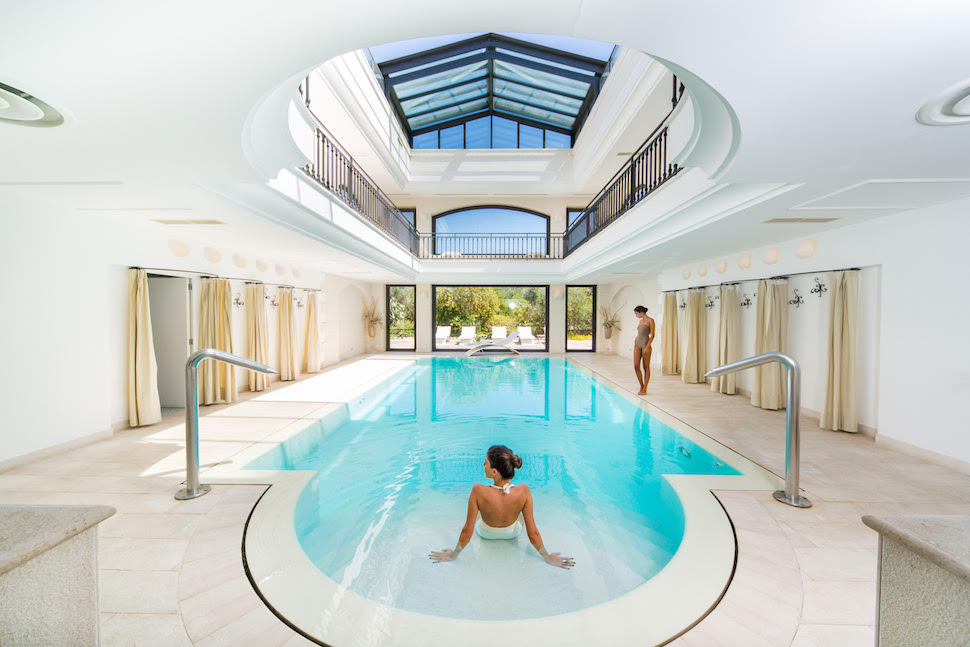
We reached Masseria San Domenico after a half-hour drive north along the coastal road from Brindisi, one of the major cities in Puglia, aka Apulia, which is located on the heel of Italy’s boot. The road beyond the entry gate passes by some of the ancient, silvery-hued olive trees among the thousand trees on the 150-acre estate. The Masseria itself is a stone, 15th-century, fortified farmhouse topped with a Templar tower tall enough to spot invaders from the adjacent Adriatic Sea. It’s the centerpiece of the 47-room, five-star boutique hotel, affiliated with The Leading Small Hotels of the World. The farmhouse estate used to be the getaway for the Melpignano family who transformed it into a small hotel and one of Italy’s few thalassotherapy spas. Like each of the hotels in Puglia affiliated with the family’s San Domenico Group, the cuisine focuses on local ingredients, which are central to Apulian heritage and culture.
Shortly after arriving, I headed across the cactus-lined courtyard to the Masseria—with its restaurants and intimate lounges—to the wood-paneled bar for my first sip of a Bombino bianco, Le Valli, by Alberto Longo (from a vineyard just north of Puglia), which the barman served with typical Apulian snacks: sliced and fried white beans, roasted almonds, and local olives. At dinner, I sampled dishes that incorporated estate-grown and local produce, including a sliced artichoke appetizer and a tomato soup with burrata.
The next morning was wildly windy and rainy; so, room service delivered a Continental breakfast on a tray crowded with four house-made preserves, orange blossom honey, a basket of pastries, and another of breads, all served on floral-patterned china. My colleague extolled all that I had missed at the breakfast buffet: smoked fish, cereals, fresh fruits, fruit juices, and vegetables, baked regional specialties and hot entrees, plus a selection of low-calorie options. The display of Apulian cheeses included fresh rounds of mozzarella, braded baby mozzarella, fresh ricotta and a tub of pungent aged ricotta and the most typical Puglian cheese, burrata, a mozzarella-like sack filled with curds and rich cream.
At lunch, I asked Chef Giuseppe Angelini to grill the Adriatic Sea Bass according to the spa’s Mediterranean Diet menu, and it arrived topped with diced tomatoes, capers, and herbs and served alongside grilled zucchini and eggplant slices.
Ceramics decorated my graciously sized room, which opened out to a private, hedge-bordered patio. Best of all, it was just a few footsteps from the seawater spa, where Maria and Antoinella welcomed me, and where I spent the entire morning. After a seaweed wrap, I soaked in the whirlpool tub and swam contentedly in the wonderfully warm, heated salt-water pool under the atrium.
Along with a room service menu, there was a Mediterranean Diet menu, which the staff nutritionist, Dr. Grassi prepares for all guests and which features daily options. Savvy spagoers may remember the term “Mediterranean Diet,” which was first introduced by Ancel Keys, a professor at the University of Minnesota in Minneapolis, in his 1970 study “Coronary Heart Disease in Seven Countries.” Actually, it refers to a style of ancient Greek-Roman cuisine, which UNESCO has recognized as was declared Intangible Heritage of Humanity, and which focuses on olive oil as the healthiest fat and, quite naturally, the one used in Pulglia. Estate-produced San Domenico olio extra vergine di olive is served at the San Domenico Hotels, and is intrinsic to the Mediterranean Diet offered to guests. The lower calorie items are rich in simple ingredients that arrive on the table unrefined, including local tomatoes (Regina, San Marzano, and Pomodorini), legumes, seasonal fruits and vegetables, most of which are grown on the San Domenico Hotel properties, or sourced locally as are the fish—including spigola (sea bass) and merluzzo (cod)—beef (Podolica beef from nearby Bari), and wine. The carbohydrates offered include whole-wheat pasta, rice, oatmeal, and rye bread.
At lunch, I asked Chef Giuseppe Angelini to grill the Adriatic Sea Bass according to the spa’s Mediterranean Diet menu, and it arrived topped with diced tomatoes, capers, and herbs and served alongside grilled zucchini and eggplant slices. The easy to replicate dish is actually, one of many Pugliese dishes—including the popular raw fish dressed in olive oil and the Caprese Salad, with slices of estate-grown tomatoes, house-made mozzarella and freshly picked basil—which are uncomplicated preparations. What makes cooking in Puglia special are the impeccable ingredients.
Beyond the Masseria, with its Thalasso spa, 18-hole golf course and beach, country roads to the Itria Valley lead to Alberobello, a UNESCO World Heritage Site and one of the hilltop, medieval città branch (white towns). Tourists flock here to see its 1500 iconic Trulli, the ancient cylindrical limestone houses with conical stone roofs topped with symbolic individualized caps, which, until 1797, were constructed without mortar. Beach lovers also go to nearby historic towns and fishing villages on the Adriatic Coast towns, such as Monopoli and Polignano a Mare, where raw seafood stars on restaurant menus.
Irvina Lew
Irvina Lew is an award-winning freelance contributor to a variety of travel books, lifestyle magazines, and websites. As a dedicated spa aficionado, the Long Island, New York native has been introducing readers to the world’s best spa venues and experiences for decades. Readers can find many of her published pieces posted on her website: irvinalew.com and by following @sipsupstayspa. Her newest book, Forays in France: A Flavorful Memoir features alluring spas in France and Monaco; some are described at foraysinfrance.com.